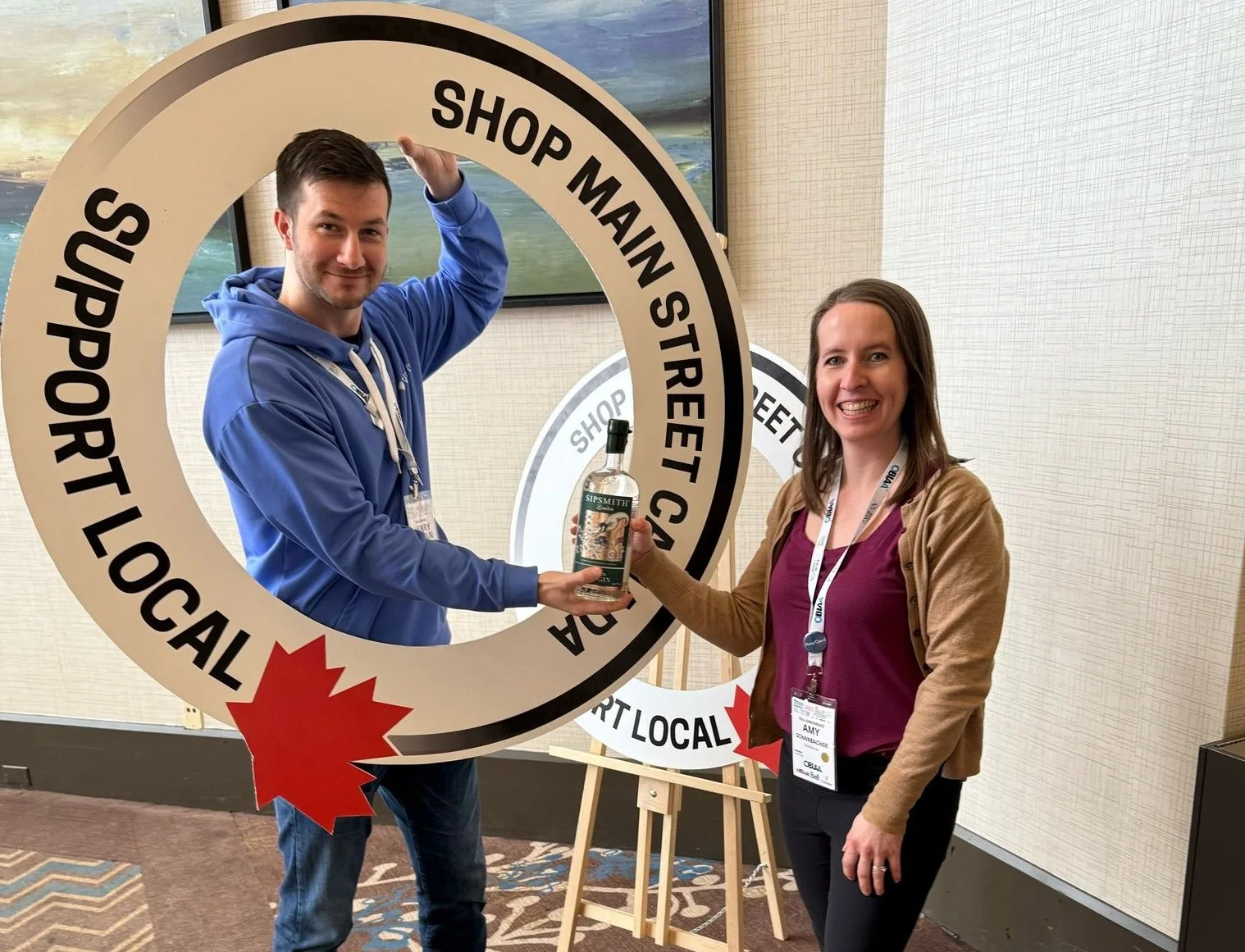Common purpose, new horizons: A British perspective on Canadian placemaking
Beach, mountain, forrest, North Vancouver, shipyards redevelopment, Squamish nation ancestral lands and modern day living and working. So many stories and aspects to Canada in one photo.
Frozen roads lead to open arms: Our Canadian Welcome.
At the end of March, Lisa and I set off for Canada with a clear mission: to learn how Business Improvement Districts (BIDs) operate in Canada and explore whether our company, Vicinity, could have a future there. The first lesson came quickly – they don’t even call them BIDs in Canada! They’re Business Improvement Areas (BIAs) for the most part (though you’ll also hear Downtown Associations or Business Improvement Zones). Despite the different terminology, the core idea is the same: local businesses banding together to improve their commercial district.
Lisa and I in Collingwood, the host BIA of the OBIAA conference.
Our journey began dramatically. We landed in Ontario only to be greeted by a frozen rain storm – a bizarre weather event where rain freezes the instant it hits the ground. In no time, everything from roads to trees was coated in ice, plunging large sweathes of Ontario into darkness. Our 75-minute drive to Collingwood stretched to over three hours. Arriving at a hotel without electricity or food, we feared the conference might be cancelled.
Collingwood’s power was partially restored just in time, and the OBIAA conference (Ontario Business Improvement Area Association’s annual gathering) went ahead as planned. From the moment we registered, we were meeting incredibly friendly Canadians, living up to their international reputation. The conference had even assigned us a “buddy”Sara Porter, who was simply the best – she welcomed us with open arms and guided us throughout the event, making sure we were never lost or lonely.
Solidarity and Identity: Canada at a Crossroads
One uplifting addition to the OBIAA conference was an opening with the national anthem. This patriotic touch set the tone for a recurring theme of our trip: solidarity and national unity. In fact, Canada is in election mode – a general election is looming on April 28. The incumbent Liberal government, now led by Mark Carney (whom UK readers will recognize as the former Bank of England Governor), faces a challenge from Conservative Pierre Poilievre.
Candidates must show strength in response to what one speaker at the conference bluntly called “the dumpster fire on the southern border.” We saw signs of protest against American influence everywhere: from liquor stores that had removed American-made spirits from their shelves, to shop windows proudly displaying signs highlighting their Canadian-made products. A new app called Maple Scan has even emerged to help shoppers identify if a product truly supports Canadian businesses. It’s clear that Canadians are flexing their national pride – voting with their wallets to “buy Canadian” and support home-grown companies.
Thankfully for us Brits, the Canadian welcome was still warm. At both the Ontario and BC conferences, when organisers announced international guests, we got a cheerful hoot for having travelled so far. American visitors, by contrast, got a polite intake of breath – and at one evening ice hockey game, even boos during the U.S. anthem! There’s no serious animosity of course, but there is a playful sense of resilience #elbowsup.
The Toronto Maple Leafs crush the Columbus Blue Jackets 5-0 on route to the Stanley Cup playoffs.
It appears affection for the Royal Family is alive and well – the late Queen Elizabeth II’s portrait still adorns the Canadian $20 bills. One BIA director from Thornbury told us a delightful story of how she created a special commemorative jam for Prince William and Catherine’s wedding in 2011, which earned her a wave of national and international attention for her town. These cultural connections reinforced that, despite an ocean between us, Canada and the UK feel like family in many ways.
Inside Canada's BIAs: Familiar Challenges, New Perspectives
The BIA conferences themselves would feel very familiar to a UK BID practitioner – sessions on economic development, leadership, improving public spaces, marketing, events and so on. The Ontario conference (OBIAA) might take the crown for entertainment value: opening with a local comedian, Jessica Holmes, who had the room in stitches with impersonations of Shania Twain and Britney Spears
Comedian Jessica Holmes opens the OBIAA conference
Throughout the panels and coffee chats, I noticed one clear difference in emphasis compared to UK BID events. Canadian BIAs certainly worry about safety, security and cleanliness in their districts, but those issues seem far less dominant than they are for us in Britain which can overwhelm a BID conference (and the trade show floor is usually packed with vendors of that ilk).
In Canada, BIAs can still focus more on beautification, marketing, and community events because the essential services are taken care of by the city. Unlike the UK, I didn’t hear about crisis in municipal finance or local councils teetering on insolvency. Canadian local authorities don’t claim to be awash with money either - and certainly they envy some of the heft of their American city neighbours - but they aren’t in emergency cutback mode to the same extent as many UK councils. This allows Canadian BIAs to stay closer to their original mission of making their districts attractive and vibrant.
Craig Stevens from Downtown Barrie presenting at the BIABC Conference.
In fact, Canada is the birthplace of the BIA concept. The very first Business Improvement Area in the world was established in Toronto’s Bloor West Village back in 1970, when local shopkeepers banded together to fight the threat of new shopping malls siphoning away customers. That innovative idea of mandatory levies caught on globally but despite that 30-year head start, Canadian BIAs haven’t changed all that much in concept since the 1970s. The mission remains familiar: keep traditional commercial areas thriving in the face of competition (these days it’s not just malls, but also Amazon and online retail stealing the crowd).
Walking around the conferences, I was struck by how small many BIAs are. Canada has an estimated 500 BIAs nationwide, including almost 300 in Ontario alone, but many represent just a few blocks of shops in a small town. Dozens of BIAs have volunteer boards with no full-time staff; and some receive extra funding from their municipality to hire an employee or two. By contrast, the UK has around 330 BIDs and even smaller towns have a paid BID manager. The grassroots, volunteer-driven spirit of the original BIA model is still very much alive in Canada – which is admirable, though it comes with challenges.
Each province (and even some individual cities like Toronto) has its own legislation governing how BIAs form and operate. In Ontario, once a BIA is established it runs indefinitely. In British Columbia, BIAs do have fixed terms and renewal votes, much like in Britain, but they have to be voted out, as opposed to voted in. In Canada generally, the BIA levy is applied to the property owners via a property tax who then passes on the cost to tenants through rent. Overall the feeling among the BIA folks is that they’d love more consistency. There have been calls for legislative changes to modernize, standardise and perhaps unify the BIA model across provinces, but these debates have been going on for some time with little change. The diversity of models is just part of Canada’s BIA landscape for now.
Amy Schanbacher of Thorold BIA, winner of the Vicinity ‘Win some gin’ competition at OBIAA.
Unlocking Potential: How Data Shapes Placemaking Success
One recurring insight that hit me, especially during my second week in Toronto meeting individual BIAs, is that Canadian BIAs face a serious data challenge. In Ontario privacy laws and other hurdles make it very hard for a BIA to get basic information on the businesses and property owners in their own district. As a result, most BIA managers spend countless hours pounding the pavement, door-knocking to manually gather these details.
They piece together their business directories like a jigsaw puzzle with 60% of the pieces missing. It’s exhausting work that, frankly, should be unnecessary – this kind of baseline data ought to be available to a local improvement organisation as a matter of course. In British Columbia the situation is a little better; BC’s assessment authority actually publishes property data online, so a Vancouver-area BIA can at least look up the properties on their patch. But in Ontario, no such luck. One BIA director in Toronto told me it took her three years to finally compile a complete list of all the businesses in her area, and even then ownership info was scant.
Because of these challenges, most BIAs never really know their full universe of stakeholders. Many admitted they don’t have contact information for a large chunk of the property owners in their district – quite a few of those buildings are owned by faceless real estate investment trusts or foreign investors who aren’t exactly walking into the local shops.
Offices above the ground floor retail are another blind spot; if a BIA’s focus (and limited resources) are directed at the main street storefronts, the businesses on upper floors or side streets might not get much attention simply because they’re harder to reach. Instead, BIAs tend to focus on what (and who) they can see: the ground-floor small businesses and the broader community footfall.
The lack of term limits or renewal ballots for most BIAs also plays a role here. In the UK, a BID’s mandate expires every five years and it has to campaign for re-election via a new ballot of its businesses. That process forces a BID to keep robust records (so it knows who is eligible to vote, who the levy payers are, etc.) and it creates a strong incentive to demonstrate results regularly. In Canada, if a BIA rolls on indefinitely once established, there isn’t the same structural push to maintain up-to-date records or prove your performance to secure a “yes” vote. Accountability does exist – for instance, members can organise to vote down the BIA’s budget at an AGM, and a city council can dissolve a BIA or put it on hiatus if things go awry – but this is rare.
The result is many smaller or purely volunteer-run BIAs haven’t adopted the kind of professional data practices that we’re now seeing in UK BIDs. And without good data, it’s harder for them to professionalise in other ways too. This isn’t a criticism – in many ways Canadian BIAs have a grassroots, community-driven character that BIDs in the UK (some of which have become quite corporate by comparison) might envy. It just means they are operating with a big information handicap. As I shared stories about how we track levy payers and measure footfall or retail mix in the UK, I saw a lot of intrigued faces and also a few looks of “if only we could do that.”
Lisa and I enjoying the drinks reception at OBIAA’s gala dinner.
Exploring Opportunities: BIAs and Vicinity
After Lisa headed back home, I spent the second week solo in Ontario. My diary filled up quickly with meetings in Toronto and the surrounding region.
A tour of the Toronto Blue jays stadium with TABIA Executive Director, John Kiru.
Word had gotten out that there was a strange highlighter-styled British “BID guy” in town with a penchant for data, and I was soon hopping between meetings and enjoying incredibly insightful chats with BIA managers curious about what we do differently across the pond. These discussions culminated in our first ever international podcast recording with Julie (back in the UK) and our first ever guest: Rachel Braithwaite, the incoming Executive Director of OBIAA. (Coming soon!) By the time I left Toronto, I was convinced there is a real appetite for better data solutions among Canadian BIAs – but also clear that whatever we propose must be sensitive to their constraints and scaled to their resources.
Podcast recording at Associated Podcasts studios in Etobicoke, Toronto.
Fast forward to week three: I flew five hours west to British Columbia for the BIABC conference (the BIA association of BC) in North Vancouver. The change of scene was striking – I swapped Ontario’s ice storms for sunny Vancouver skies and cherry blossoms. Vancouver truly impressed me: fresh salty air off the Pacific, lush green forests within walking distance of downtown, and snow-capped mountains looming on the horizon. (There’s a famous saying that in Vancouver you can hit the beach in the morning and be skiing in the afternoon – I believe it, but will have to go back to experience it)
A view across the Burrard inlet from high up in one of Downtown Vancouver’s skyscrapers.
The BIABC conference location was a beautifully redeveloped former shipyard on the North Shore. A walking tour from former North Vancouver Mayor Darrell Mussatto, showed us how 20 years of vision and investment transformed an industrial waterfront into a vibrant mixed-use community. I’ve never seen a politician so beloved: local residents showered him with kind words and broad smiles. One lady on our tour even shared that Darrell had saved her life years ago when he was a paramedic! I had to ask myself if I’d wandered onto a movie set. And here’s something every downtown manager can appreciate: this North Vancouver neighbourhood now has packed restaurants every night of the week, even Monday–Wednesday. Many BIA delegates were envious of that kind of consistent footfall and economic activity.
Final Reflections: Shared Values, Shared Future
As I write this back home, I feel incredibly fortunate to have had the opportunity to make this trip. It was a whirlwind – two provinces, two conferences, more meetings than I can count. Huge thanks are in order: first to Lisa, who was a superstar companion through the first week. Thanks also to every Canadian who welcomed us, taught us, or simply shared a meal or a laugh. I return to the UK inspired by the pioneering spirit that still lives in Canada’s BIAs and communities.
On a more sobering note, one disappointment was the lack of support we received from our own UK government for this exploration. Until recently, Innovate UK ran a grant scheme to help small businesses like ours expand internationally – a little financial boost that could have gone a long way – but it was scrapped. So much for promoting exports and growth! For a small company like Vicinity, self-funding a trip of this scale was not a trivial undertaking and involved some risk. I’m extremely grateful to my dedicated team back home who kept the fires burning, launching new apps and supporting our UK BID customers while I was away on this Canadian adventure. Like many BIDs/BIAs themselves, we’re under pressure to do more with less, and one thing that became clear is that tapping into international markets could be a key to our sustainability. In an industry that’s all about community and collaboration, why should those values stop at national borders?
Ultimately, what I take away from Canada is a renewed faith in the collaborative spirit of people coming together to improve their place – whether we call it a BID or a BIA. Despite differences in context and scale, our Canadian counterparts share the same passion for community, the same challenges of rallying businesses, and the same gratification when a project makes a positive difference on the high street. There is much we can learn from each other. I believe strongly that by sharing knowledge and tools across our two countries (and the wider Commonwealth), we can help each other tackle whatever the future holds for our town and city centres.
We went to Canada wondering if Vicinity might have a role to play there. We came back convinced not only that there’s opportunity in Canada for us, but that any exchange of ideas is a two-way street – there’s also so much that Canadian BIAs and UK BIDs can teach one another. That sense of common purpose across the pond is perhaps the most rewarding outcome of all. Here’s to many new friendships and to the exciting possibilities ahead for both Canadian BIAs and our little UK team as we pioneer together!
Beaver Lake in Stanley Park, a short walk from the heart of Downtown and West End Vancouver. A Wood Duck in the foreground.












